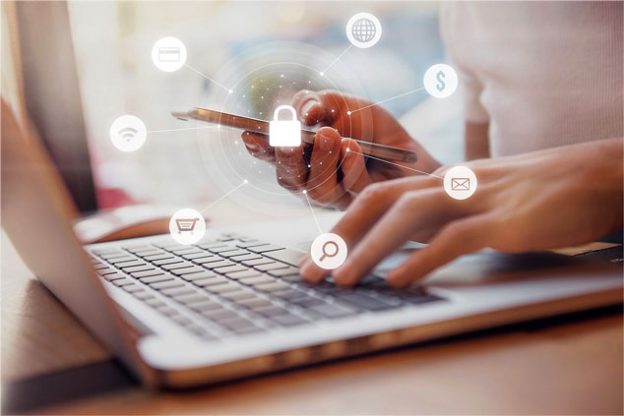Today, it’s estimated that the global cost of cybercrime has skyrocketed to being a whopping $45 billion. And a major portion of this is directly related to phishing scams, which are one of the most common tactics used by fraudsters to compromise accounts and carry out their crimes.
In fact, according to ZDNet.com, roughly 1.4 million fraudulent phishing websites are created every single month.
Often times, these websites are built to look exactly like a trustworthy website. However, phishing websites are designed solely with the intention of stealing their users’ sensitive information, rather than serving them any sort of real purpose.
In the following article, we’re going to take a look at fraudulent phishing websites, as well as how you can spot them and what you can do to protect your identity online.
What Is Phishing?
Phishing is a form of cybercrime where fraudsters attempt to obtain valuable information, such as a person’s usernames, passwords, or banking information. This is done by the fraudster disguising themselves as a trustworthy person, website, or organization.
In most cases, the victim is lured to a fraudulent website via some form of mass digital communication sent out by the fraudster. This could be an email, text messages, or direct message on social media.
Either way, in the communication, the fraudster will identify themselves as a trusted party, often a bank, Paypal, or a social media platform. The message will usually claim that there is some sort of issue with the user’s account and that they need to log in to address the problem.
The victim will then be lead to a sign in page, one that looks exactly like the website the fraudster is claiming to represent. However, when the victim enters his or her account information, instead of being brought to their account, the fraudster will have just obtained their account information.
The problem with these websites is that fraudsters are now making it extremely hard to tell if you’re looking at a legitimate website, or if you’re looking at a fake, phishing website.
Fortunately, by taking a look at a few key indicators, you can easily tell if a website is on the straight and narrow, or if it should be avoided at all costs.
Now, with that out of the way, let’s take a look at a few ways to spot fraudulent websites. Then, we’ll leave you with a few tips to ensure your identity is safe while you’re browsing the world wide web.
So, how can you spot a fake website? Here’s another interesting blog post about “How to verify website authenticity”
Examine Your Browser’s Address Bar
While often overlooked, the tiny address bar in your web browser can display a ton of valuable information about the website you’re looking at. Therefore, your browser’s address bar should be one of the first places to look to see if a website is legit or not.
Often, a fraudster might try to dupe an unsuspecting internet user by hiding their fraudulent website’s domain name behind a sud-domain.
Now, I know this might sound a bit confusing, but let me explain.
A domain name is the address that you type in when searching for a specific website. S, for example, if you wanted to find PayPal’s website, you would type in “www.paypal.com”.
“Paypal.com” is the domain name.
A fraudster, on the other hand, might create website address that look like this: “https://paypal.signin.com.verified-paypal-portal.com/accounts”
While it’s easy to be tricked into believing that this address is for PayPal’s website, it’s only designed to look like a website address owned by PayPal.
So to easily spot a web address’ domain name, simply look for the words that precede the final “.com” part of the address. So in this example, “verified-paypal-portal.com” would be the actual domain and “paypal.signin.com” is the sub-domain.
With this example, it’s easy to see how fraudsters can use this little trick to engineer their website addresses to look very similar to an authentic and trustworthy website’s domain.
That’s why it’s important to always look at a website’s address, especially if you’ve been directed to the site from any type of suspicious or out-of-the-ordinary message coming from a major organization
Check The Site’s Connection Security
When you request a website in your web browser, you’ll either connect to it via HTTP or HTTPS connection.
HTTP or Hypertext Transfer Protocol is a programming language that was, essentially, used to build the internet.
Initially, HTTP didn’t serve any type of commercial use. In fact, at the time, online commercial activity was illegal since the internet was only designed to be a platform used for the exchange of data and information.
And because HTTP was not designed with any commercial intent, it wasn’t designed to be very safe or secure. In other words, any information being exchanged via an HTTP website connection can easily be intercepted, stolen, or manipulated by anyone else who may be connected to the website.
Eventually, web developers created the HTTPS connection.
HTTPS is simply the HTTP programming language, combined with an additional layer of security, known as SSL or Secure Sockets Layer. This additional layer of security prevents any communications being made across the connection from being intercepted by anyone other than the user and the website that they’re connected to.

While this might like a bit much to take in, the important thing to remember is that you should never trust a website on an HTTP connection.
But how can you tell if a website is using an HTTP or HTTPS connection? Simple!
For starters, simply take a look at your browser’s address bar again.
If the website’s URL starts with HTTPS, you can be sure the website is using a secured connection.You’ll also sometimes see a small padlock icon next to the beginning of the URL. This padlock shows that the website is secured via HTTPS connection.
On the other hand, if the website’s URL starts with HTTP or if it doesn’t display the padlock icon, you’ve likely spotted yourself a fraudulent website.
Look For Badges Or Trust Seals
Badges or trust are typically placed on a website to let visitors know that they’re using a safe, secure website that’s trusted by other organizations.
For example, you’ll often see a PayPal trust seal on e-commerce websites to notify users that any purchases or transactions made via the website are secured by PayPal.
Trust seals often appear as a company’s logo on another company’s website, signifying that the two companies are partnered together and can be trusted with your personal information.
You’ll typically find trust seals on a website’s homepage, login page, or on their checkout pages if they sell products or services via the site. Generally, trust seals are easy to spot and are usually displayed rather prominently.
It’s also important to note that trust seals can be clicked to display more information about the site’s SSL certificate, as well as any other security measures they have put in place.
With that being said, seeing a trust seal on a website isn’t enough to confirm its authenticity. But if you can click on the trust seal, and it displays up-to-date information about the site’s SSL certificate, you can be sure you’re on a safe site.
So if you ever find yourself on a website, especially one that accepts payments, and it doesn’t display any clickable badges or trust seals, it’s best to avoid using the website at all costs.
So now that you know a few ways to spot fake websites, let’s review a few things you can do to keep yourself safe while using the internet.
Protecting Your Identity While Online
No matter how much you learn about spotting fake or fraudulent websites, the fact is that cybercriminals are constantly looking for ways to make their scams harder to spot..
Fortunately, there are a few things you can do to make your online browsing that much safer.
Here’s an interesting API Reverse WHOIS which you can use to search for domain records based on particular search terms.
Below, we’ll take a look at a few important tips for staying safe while online.
Install Anti-Virus Software
Without a good anti-virus software installed on your computer, you’re putting your device, as well as your personal identity in serious jeopardy. Without this type of software present, it’s extremely easy for cybercriminals to attack your computer while it’s connected to the internet.
Not only does anti-virus software catch and neutralize threats that may be present, it will also regularly scan your computer to prevent any future infections.
Therefore, make sure that you’re running some form of anti-virus software on your computer, and ensure that it’s current on all the latest updates.
Avoid Unsecured Networks
In today’s busy world, it’s not uncommon for a person to find themselves relying on public Wi-Fi sources to connect to the internet while away from home. However, it’s important to understand that public Wi-Fi networks pose a serious threat when it comes to your online security.
That’s because public networks are, well, exactly that: they’re public.
And in many cases, these public networks aren’t protected by passwords or any other type of security measure. In other words, anybody with a computer or device can sign on and use the network. And that includes fraudsters and cybercriminals who can easily target other users connected to the same network.
While there’s no real way for you to tell who else is using the same network as you, there is one way you can keep yourself safe while browsing the internet on a public Wi-Fi network: installing and using a VPN.
Install A VPN
According to Wikipedia, a VPN, or Virtual Private Network is a private network of servers spread out across the world. Essentially, VPNs allow users to connect to the internet safely and anonymously while browsing the internet.
At the same time, any computers or devices connected to the VPN will benefit from the network’s functionality and security. And in most cases, the network will also be completely encrypted from end to end, meaning that it’s virtually impossible for anyone to see or track any of your online activity.
To benefit from a VPN’s security, you’ll first need to download and install the VPN software from the provider of your choice. Once installed, you’ll be able to connect to the internet by choosing any one of the network’s private servers. Then, you’ll be able to browse the internet safely and anonymously.
Spotting Fake Websites
Since the advent of the internet, cybercrime has gone from being virtually non-existent to costing an estimated $45 billion in recent years. And sadly, this number is only expected to continue to rise in the coming years.
This is because fraudsters are constantly looking for new ways to scam people and they’re getting to be extremely good at what they do. In fact, today, it’s practically impossible to tell if the website you’re looking at is real or not.
Unless, of course, you know what to look for.
By following the tips discussed in today’s article, you should now be able to easily spot a fake website simply by looking at the site’s domain name, checking its connection, and by looking for trust seals.
Finally, if you ever have any sort of inkling or “gut feeling” that a website might not be legitimate, you’re better off to avoid it completely. In the end, it’s better to be safe than sorry.
Laila Azzahra is a professional writer and blogger that loves to write about technology, business, entertainment, science, and health.
